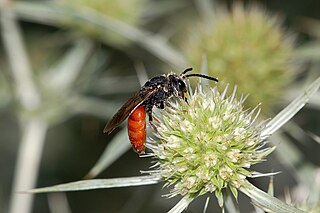
Halictidae is the second-largest family of Anthophila bees. Halictid species occur all over the world and are usually dark-colored and often metallic in appearance. Several species are all or partly green and a few are red; a number of them have yellow markings, especially the males, which commonly have yellow faces, a pattern widespread among the various families of bees. The family is distinguished by the arcuate basal vein found on the wing.

Sphecodes albilabris is a solitary parasitic bee that is endemic to Central and Western Europe. The larvae of this species are parasites of Colletes cunicularius.
Heinrich Friese was a German biologist and entomologist, specialist of bees (melittologist). Between 1883 and 1939 he described 1,989 new species and 564 new varieties or subspecies of insects, 99% of which were bees.
Sphecodes biroi is a species of bee in the genus Sphecodes, of the family Halictidae.
Sphecodes crassicornis is a species of bee in the genus Sphecodes, of the family Halictidae.
Sphecodes decorus is a species of bee in the genus Sphecodes, of the family Halictidae. S. decorus has been documented in India and Sri Lanka.

Sphecodes crassus, common name swollen-thighed blood bee, is a species of bee. It was described by Carl Gustaf Thomson in 1870.
Sphecodes schenckii is a solitary cleptoparasitic bee which is found in southern and eastern Europe and the Middle East. Its host is Lasioglossum discum and possibly Halictus simplex where L. discum does not occur such as in southern Germany and Switzerland. It is rare and there are only a few records from each country from which it has been recorded. It prefers warm open areas, such as grasslands and Mediterranean scrub, and may be threatened by reafforestation and vegetation succession. The specific name schenckii is in honour of the German Hymenopterist Adolph Schenck.

Sphecodes is a genus of bees from the family Halictidae, the majority of which are black and red in colour and are colloquially known as "blood bees". Sphecodes bees are cleptoparasitic on other bees, especially bees in the genera Lasioglossum, Halictus and Andrena. The adults consume nectar, but because they use other bees' provisions to feed their offspring they do not collect pollen.

Sphecodes gibbus, the dark-winged blood bee, is a species of cleptoparasitic blood bee from the Palearctic. It is the type species of the genus Sphecodes and was first described by Carl Linnaeus as Sphex gibba in 1758.
Sphecodes confertus is a species of sweat bee in the family Halictidae.
Sphecodes heraclei is a species of sweat bee in the family Halictidae.
Sphecodes aroniae is a species of sweat bee in the family Halictidae.
Sphecodes solonis is a species of sweat bee in the family Halictidae.
Sphecodes johnsonii, or Johnson's sphecodes, is a species of sweat bee in the family Halictidae.

Sphecodes ferruginatus is a Palearctic species of sweat bee.

Joseph von Hagens was a German entomologist who specialised in Hymenoptera especially Apidae and Coleoptera.







